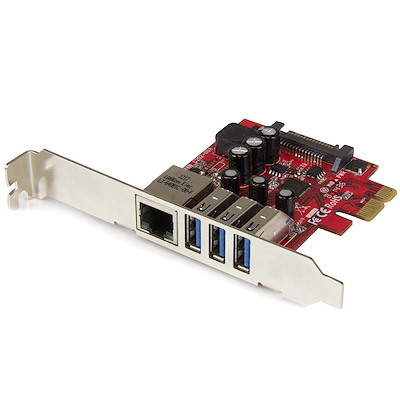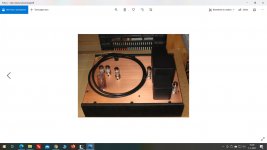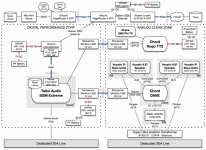Hello,
Exactly! That is why i think the Stationpi will give a good return on investment in most situations if not all.
Sometimes you will come across information that could be useful. I read on a website from a local company , a big player in screening material , little enclosures and even complete rooms that a '' disturbance '' can easily leave or enter a space if there is even a slight disruption in the screen by an element like a door or even a connector. So that is why i went for the extruded boxes from up in the attic. I cant imagine they will not be a little better than a Hammond enclosure with a separate top plate and some plastic parts as well.
I am sure Andrea can tell us if it could be beneficial to cover just the clock with a round/ or square '' hat '' connected to the groundplane. Probably these things can be measured. And it will be not to difficult to install before sliding the board into the box.
Greetings, eduard
P.s the screening copper mesh around input tube of my phonostage made by a famous Dutch designer
Exactly! That is why i think the Stationpi will give a good return on investment in most situations if not all.
Sometimes you will come across information that could be useful. I read on a website from a local company , a big player in screening material , little enclosures and even complete rooms that a '' disturbance '' can easily leave or enter a space if there is even a slight disruption in the screen by an element like a door or even a connector. So that is why i went for the extruded boxes from up in the attic. I cant imagine they will not be a little better than a Hammond enclosure with a separate top plate and some plastic parts as well.
I am sure Andrea can tell us if it could be beneficial to cover just the clock with a round/ or square '' hat '' connected to the groundplane. Probably these things can be measured. And it will be not to difficult to install before sliding the board into the box.
Greetings, eduard
P.s the screening copper mesh around input tube of my phonostage made by a famous Dutch designer
Attachments
Yes, only Thunderbolt3 optical is non-hybrid. USB optical needs to be USB 2.0 compatible so you need some type of power. It's more of a VBUS power like the gold/cooper cable outside of the USB data in this photo:

My DAC needs VBUS to handshake, so I'm glad it is there. You can workaround and isolate by powering with a 5V battery pack. What I plan to use is 6.6V from the MKIII to Ian's LPS to UcConditioner 5V to power the USB optical cable.

This workaround has been done successfully with $30,000 Music Servers. The impressions have similar characteristics if you switched to toslink optical. Positive impressions thus far.
It's not perfect, but the more isolation the better. If it works with $30K Music Servers, I should be okay with it too.

My DAC needs VBUS to handshake, so I'm glad it is there. You can workaround and isolate by powering with a 5V battery pack. What I plan to use is 6.6V from the MKIII to Ian's LPS to UcConditioner 5V to power the USB optical cable.

This workaround has been done successfully with $30,000 Music Servers. The impressions have similar characteristics if you switched to toslink optical. Positive impressions thus far.
It's not perfect, but the more isolation the better. If it works with $30K Music Servers, I should be okay with it too.
Maybe the case acts more as an antenna rather than as a shield. It might do some of both. Maybe try a solid steel case and see if you get a different result.
Yes could be ! I just removed the case for the moment...
Hello,
THAT is the reason i will surely go for the Stationpi design. One might say that short connections are mandatory for perfect quality but if two boards are kind of disturbing each all the time it is a bit silly to add things like ultracap boards because those probably wont diminish those disturbances.
I remember when making my DDDAC chassis i did some tests about position and orientation of the Lundahl chokes. I remember Doede telling me that the main board doesnt care to much about chokes close by. AND of course lundahl chokes dont '' spread '' a lot of garbage because the way they are constructed.
But is seems that with '' front end '' parts like clocks it is easy to do something that will diminish sound quality. Not that it is wrong but it can be done better without investing more time and money. And a few of those somethings could add up to something bigger that you cannot compensate by investing an extra 1000 euro.
I think that if executed the right way most circuits here will work better if screened properly.
Of course most people here are constantly trying to improve their diorama that came with just a single mounting plate.
Greetings, Eduard
So easy to spend money in the wrong direction!
Best thing is try the cheap solutions first.
By the way, there's many RFI and EMI absorbing sheets to choose from, so this is something cheap to experiment with, and something that any circuit will benefit from
Best, Bart
^+++Eduard
I am sure you mean no disrespect. Your assumption about the financial motivation of Ian and Andrea is a bit troubling. We have two really competent with serious day jobs working their spare time to share their stuff via group buys. Andrea admits he lost money running the 2019 GB but did not come back to us to top up the budget. Ian has been generous often giving me free stuff to go along with great value group buys. I think we just need to be thankful for the work of all three of these guys. I'm sure you feel the same, but I just wanted to say thanks to these guys for all of us.
The reason I want to go 12V motherboard vs NUC is not only the trend to move to more powerful Music Servers (I can put in an i9 or Xeon), but so I can utilise the PCIe slot for USB adapters to have direct access to CPU, isolation from MB internals and reduce USB noise, Ethernet noise, etc. Also in that I can use industrial RAM since RAM is very important for SQ:

I won't be able to do this now with an old NUC without a bottleneck mini adapter, but hope to one day if I build a powerful battery-powered PC Music Server. I would of preferred PCIe USB adapter -> Slimrun USB optical -> Uptone USPCB -> Combo384, but have to settle and experiment with Motherboard USB -> Slimrun USB optical -> Uptone USPCB -> Combo384.
For an example of how the SlimRun USB optical is implemented in a real world audiophile setting, please see attachment:

I won't be able to do this now with an old NUC without a bottleneck mini adapter, but hope to one day if I build a powerful battery-powered PC Music Server. I would of preferred PCIe USB adapter -> Slimrun USB optical -> Uptone USPCB -> Combo384, but have to settle and experiment with Motherboard USB -> Slimrun USB optical -> Uptone USPCB -> Combo384.
For an example of how the SlimRun USB optical is implemented in a real world audiophile setting, please see attachment:
Attachments
Last edited:
@dddac,
Read you blog entry. One concern I might have is that plugging and unplugging the TENT clock will keep turning its power on and off, which probably makes its phase noise less stable than it would be if left running continuously on clean power. IME the Accusilicon AS318-B clocks as implemented in Topping D90, and in the Chinese USB boards that use the tiny SMD version AS318-B, take about 3-days of continuous power with clock output enabled before they sound their best. Same experience with Crystek 957 used with my AK4499 dac. For my dac tests were done to make sure only clock warmup was being considered. The dac was kept running while the test clocks were warming up so that of the dac itself was also fully warmed up.
As an aside, might mention some clock modules may sound better if decoupled with 805 SMD PPS film caps rather than the mix of X7R and NPO/C0G that ian supplies for use with his little clock adapter boards (not sure what is on FIFO_Pi PCB).
So far, I have done some comparison of Andrea's clocks with 11Mhz crystal and one doubler (also with 24MHz crystal and no doubler), verses my CCHD-957 implementation for AK4499. Andrea's are better, but only slightly so for my dac. For those tests both clocks were left running continuously for at least 3-days and they were switched using a small SMD gold-contact relay. Tests were done to make sure there was no audible stray capacitive coupling effects between clock signals in the relay.
Read you blog entry. One concern I might have is that plugging and unplugging the TENT clock will keep turning its power on and off, which probably makes its phase noise less stable than it would be if left running continuously on clean power. IME the Accusilicon AS318-B clocks as implemented in Topping D90, and in the Chinese USB boards that use the tiny SMD version AS318-B, take about 3-days of continuous power with clock output enabled before they sound their best. Same experience with Crystek 957 used with my AK4499 dac. For my dac tests were done to make sure only clock warmup was being considered. The dac was kept running while the test clocks were warming up so that of the dac itself was also fully warmed up.
As an aside, might mention some clock modules may sound better if decoupled with 805 SMD PPS film caps rather than the mix of X7R and NPO/C0G that ian supplies for use with his little clock adapter boards (not sure what is on FIFO_Pi PCB).
So far, I have done some comparison of Andrea's clocks with 11Mhz crystal and one doubler (also with 24MHz crystal and no doubler), verses my CCHD-957 implementation for AK4499. Andrea's are better, but only slightly so for my dac. For those tests both clocks were left running continuously for at least 3-days and they were switched using a small SMD gold-contact relay. Tests were done to make sure there was no audible stray capacitive coupling effects between clock signals in the relay.
Last edited:
I thought about this of course - the clocks were a week on power. than unplugging a few minutes would give a total reset and need days of power again? I thought this unlikely and the differences were clear anyway. It was not meant as kind of absolute measurement. Also this way is probably closer to reality. I am not sure everyone keeps his DAC gear switched on 7/24 ?
But point taken and considered a solution for this (separate power and relay switch (use two?))
But point taken and considered a solution for this (separate power and relay switch (use two?))
IME for very brief power outages the clocks recover pretty fast. OTOH, off overnight (say, 8-12 hours) required the full 3-days to completely recover.
While saying the following is likely to draw attention from certain trolls, I will say it anyway: Clocks are not the worst component settling time wait I found so far. Certain film caps in the audio path can take about 2-weeks to fully settle. Of course, they also take longer to become unsettled if unused. In that case it seems to have to do something to do with DA, since reversing the DC polarity on a settled cap requires another two weeks to fully settle out again. This is something I found out when caps were mounted on gold pin headers for quick A/B comparisons. If the presumptively non-polar caps were replaced in reverse polarity during A/B testing there was an audible difference until they were given enough time with the reversed polarity to settle again.
While saying the following is likely to draw attention from certain trolls, I will say it anyway: Clocks are not the worst component settling time wait I found so far. Certain film caps in the audio path can take about 2-weeks to fully settle. Of course, they also take longer to become unsettled if unused. In that case it seems to have to do something to do with DA, since reversing the DC polarity on a settled cap requires another two weeks to fully settle out again. This is something I found out when caps were mounted on gold pin headers for quick A/B comparisons. If the presumptively non-polar caps were replaced in reverse polarity during A/B testing there was an audible difference until they were given enough time with the reversed polarity to settle again.
Last edited:
At 60mW power, it is pretty easy to justify leaving powered 7/24. With the oven baking away on the earlier version, it could be a concern.
Mark, I am surprised that you see such a marginal improvement with these clocks vs CCHD-957 on your AK4499. IMO the Crystek is comparable to the NDK SDA I ran and the difference between the NDK and these clocks could not be considered close on a 30 year old DAC chip.
Do you have a theory why the AK4499 is less sensitive to jitter? Or do you assert that others imagine a greater difference? I do recall you being quite critical of anyone paying substantial money for a clock. Are you returning to that position?
Mark, I am surprised that you see such a marginal improvement with these clocks vs CCHD-957 on your AK4499. IMO the Crystek is comparable to the NDK SDA I ran and the difference between the NDK and these clocks could not be considered close on a 30 year old DAC chip.
Do you have a theory why the AK4499 is less sensitive to jitter? Or do you assert that others imagine a greater difference? I do recall you being quite critical of anyone paying substantial money for a clock. Are you returning to that position?
Took some experimentation with power supplies, PCB layout, clock loading, and decoupling to get the best out of the Crysteks. Haven't seen anything from here in the forum that IME is good enough to get the best out of them. OTOH Andrea has put a lot of engineering work into the design of his clock systems, so that element is very well optimized.
Since I don't have a Time Pod I just have to use my ears and experiment. Most people here don't do it that way. IMHO audio design is different than most other engineering because we don't know how to specify exactly how something will sound in terms of measurements. Almost everything else is specified only in terms of measurements. That said, I do have a pretty good scope which I use a lot.
EDIT: Its also true that some dac chips/boards are designed to be more jitter tolerant than others. Rob Watts claims that he can design a dac to be as jitter tolerant as needed; he says it take more output elements (shift register outputs) where the actual D to A conversion is done if more jitter tolerance is needed. He is speaking about delta-sigma converters of course.
Since I don't have a Time Pod I just have to use my ears and experiment. Most people here don't do it that way. IMHO audio design is different than most other engineering because we don't know how to specify exactly how something will sound in terms of measurements. Almost everything else is specified only in terms of measurements. That said, I do have a pretty good scope which I use a lot.
EDIT: Its also true that some dac chips/boards are designed to be more jitter tolerant than others. Rob Watts claims that he can design a dac to be as jitter tolerant as needed; he says it take more output elements (shift register outputs) where the actual D to A conversion is done if more jitter tolerance is needed. He is speaking about delta-sigma converters of course.
Last edited:
@ A1213
please start your own thread - I want to read about FiFoPi here. This goes way too far off topic. No offence but Ian's thread is already being watered too much
my 2 cents
@dddac
No, I agree. I try my best to stay on-topic, but I hit the tail end of the thread discussing RPi internal noise so was merely pointing out offloading services and optical isolating with a USB optical solution. There were some follow-ups and ended up off-track.
I'll stop making suggestions. I need to stop posting and start DIY grinding if I am going to complete this project by Summer. I also need to research the incoming Andrea clock, so your recent blog is a big help for a complete beginner.
@dddac
Thanks Doede for sharing the nice project.
Looks very promoting. Just ordered your DDDAC KIT. I’ll try it soon with Andrea's new clock and my ReClockPi.
Regards,
Ian
- Home
- Source & Line
- Digital Line Level
- Asynchronous I2S FIFO project, an ultimate weapon to fight the jitter

